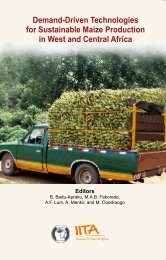Challenges and Opportunities for Enhancing Sustainable ... - IITA
Challenges and Opportunities for Enhancing Sustainable ... - IITA
Challenges and Opportunities for Enhancing Sustainable ... - IITA
You also want an ePaper? Increase the reach of your titles
YUMPU automatically turns print PDFs into web optimized ePapers that Google loves.
Cowpea genetics <strong>and</strong> breeding<br />
crop <strong>for</strong> selecting high yielding lines <strong>for</strong> intercropping. Two crosses involving IT89KD-374<br />
<strong>and</strong> IT89KD-288 as local improved parents <strong>and</strong> IT90K-48-1, which is resistant to aphid,<br />
bruchid, thrips, <strong>and</strong> Striga <strong>and</strong> Alectra, were made in 1990 <strong>and</strong> F 2<br />
seeds from the two<br />
populations were subdivided into two sets each. One set was grown in sole crop with two<br />
insecticide sprays <strong>and</strong> the other set was grown under intercropping with millet, without<br />
insecticide spray in 1991. The F 3<br />
progenies selected from these populations were grown in<br />
sole crop <strong>and</strong> intercrop, respectively, maintaining separate sole crop <strong>and</strong> intercrop streams<br />
in 1992. Likewise F 4<br />
progenies were grown in separate streams in 1993, F 5<br />
progenies in<br />
1994, <strong>and</strong> F 6<br />
progenies in 1995. The st<strong>and</strong>ard pedigree method was followed to select<br />
desirable plant/progenies while evaluating F 2<br />
to F 6<br />
generations. The promising F 6<br />
progenies<br />
were bulk harvested in 1995 <strong>and</strong> multiplied in the dry season <strong>for</strong> a yield trial under<br />
intercrop <strong>and</strong> sole crop in the 1996 crop season. A total of 52 F 6 lines selected from the<br />
segregating progenies of the two crosses advanced in sole crop <strong>and</strong> intercrop streams were<br />
yield tested along with eight checks, including the original parents as well as best local<br />
<strong>and</strong> improved checks. The trial included sole crop <strong>and</strong> a combination of 1-row millet with<br />
1-row cowpea intercropped with <strong>and</strong> without spray of insecticide. The grain <strong>and</strong> fodder<br />
yields of the breeding lines selected under intercropping were significantly better than<br />
those selected under sole crop averaged over the two crosses. The mean grain yield of all<br />
the lines derived from the sole crop was 1149 kg/ha in sole-crop sprayed <strong>and</strong> 190 kg/ha in<br />
intercrop with no spray, compared to 1328 kg/ha <strong>and</strong> 265 kg/ha, respectively, of the lines<br />
derived from intercrop. This indicated that selection under intercropping without spray is<br />
more effective <strong>for</strong> higher yield than selection under sole crop. This may be due to greater<br />
stress <strong>and</strong> selective pressure under intercropping.<br />
In a comparative study of different breeding methods, the mean per<strong>for</strong>mance of F 3<br />
progenies derived from single seed descent method was better than that of progenies<br />
developed via single plant selection <strong>for</strong> yield <strong>and</strong> yield components (Mehta <strong>and</strong> Zaveri<br />
1997). Also, the broad-sense heritability was higher in the population developed through<br />
the single seed descent selection method. Vishwanathan <strong>and</strong> Nadarajan (1996) conducted<br />
G × E analysis of several cowpea varieties <strong>and</strong> they observed IT86D-1056 <strong>and</strong> C04 cowpea<br />
varieties to be the most stable. Singh (2000) showed that by testing <strong>and</strong> selection of varieties<br />
at known hot spots <strong>for</strong> different diseases, insect-pests, <strong>and</strong> Striga/Alectra, the genotype ×<br />
environment interaction can be minimized to ensure stable per<strong>for</strong>mance of improved varieties<br />
over a wider range of environments. He also showed that by simultaneously testing<br />
<strong>and</strong> selecting under sole crop with only two sprays of insecticide, sole crop without spray<br />
<strong>and</strong> intercrop without spray, high yielding varieties with stable per<strong>for</strong>mance with little<br />
or no insecticide could be identified (Singh 1999a, 2000). Diallel analysis of six cowpea<br />
genotypes <strong>and</strong> their F 1<br />
hybrids revealed additive gene action <strong>for</strong> most of the quantitative<br />
traits including green fodder <strong>and</strong> total dry matter (Ponmariammal <strong>and</strong> Das 1996).<br />
Interspecific crosses<br />
Gomathinayagam et al. (1998) reported successful crosses between Vigna vexillata <strong>and</strong><br />
Vigna unguiculata using embryo culture. They grew the F 1<br />
hybrids <strong>and</strong> harvested F 2<br />
seeds<br />
that were planted <strong>and</strong> then backcrossed to V. unguiculata. However, the resulting backcross<br />
seeds looked closer to Vigna vexillata. There<strong>for</strong>e, there is a need to further examine the<br />
progenies obtained from this cross be<strong>for</strong>e ascertaining whether this was a true hybrid.<br />
Tyagi <strong>and</strong> Chawla (1999) also reported successful crosses between Vigna radiata <strong>and</strong><br />
24
















